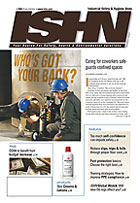
It was Friday at 3:30 p.m. when I got the call. “We are wrapping up the job! Wanna meet me at the confined space entrance so we can do the wrap-up walk-around?”
“Sure thing,” I replied. “See ya in ten minutes.”
I grabbed my hat and glasses and walked out the door. Part of my safety and environmental specialist responsibilities is to perform a closing meeting with contractors and ensure that the worksite is free of hazards, locks have been removed, and spills were reported and cleaned before the contractor signs off on the completed job. This was a large job that required about 500 contractors and supervisors to work 12-hour days for a 21-day stretch, and we were particularly proud that there were no recordables.
Did I mention that a third of the workers were waiting on my final walk-through before leaving for a long, well-deserved weekend? Many of these guys had not seen their families in almost a month, and I could not get there soon enough.

Thank you, Lois
As I walked up to the construction site, Tom, the contractor safety manager, greeted me and we proceeded to the confined space. Just before entering the space we were stopped by Lois, the confined space attendant. She asked us to sign in and present our confined space training cards. She then observantly pointed out that I did not have a personal monitor.Tom said, “There’s no work going on. Come on, we’ll just be a minute.” Lois was persistent. I grinned at Tom knowing that I knew better than to come there without my monitor. As I walked back to my office to get the monitor I thought to myself, “It is people like Lois who keep job sites like this one safe.”
After retrieving my monitor, Tom and I signed in and started going through the checklist. Tom was in a hurry, so he wandered ahead of me. Just then my monitor alarmed. It read, “CO 198ppm.” I yelled, “Tom, we need to evacuate, something has changed!”
As we started for the door a loud air horn pierced through the entire confined space like a freight train in a tunnel. Lois’ monitor had also picked up the high carbon monoxide reading, and she was exercising the evacuation procedure. The few remaining workers inside the confined space scurried for the entrance as the air horn continued to blare.
After we stepped out, Lois made sure we signed out. She then sighed with relief and said, “Thank goodness everyone is out and accounted for.”
I noticed that while we were inside, a crane had begun setting up for the next phase of the job, and due to the proximity to the confined space it acted as a funnel for the carbon monoxide to enter. Tom said, “Wow, we got lucky!”
Taking pride
Most job sites have many people like Lois who take pride in their jobs and are diligent in protecting the folks for whom they are responsible. Lois is not a supervisor or manager — just someone who cared enough to understand her responsibilities and carried them out no matter who entered her area.Each person on the job site that day had a responsibility to ensure everyone’s safety:
- The company equipment owners made sure that all of the appropriate lockout/tagout, block and bleeds, and training took place for the equipment, chemicals and hazards in the process area.
- The confined space entrants used the buddy system and continuously monitored the atmosphere, looked out for trip hazards and other hazardous obstacles, and made sure that appropriate PPE was used. The entrants also made sure that the atmosphere readings, lockouts and permits were current each day before entering.
- The attendant (that would be Lois) needed to know who was in the space at all times; have means to call for help; and evacuate the space if anything were to change.
- The field supervisor watched the “big picture” looking out for rushing, fatigue, making sure that the fabricators and welders were at a safe distance from each other. He took atmosphere readings before each shift and after each break. The supervisor attended daily meetings and offered support and encouragement on how the company thought the job was progressing.
- The rescue team was also prepared. Their equipment was stationed at the entrance, and they could be called quickly. Because everyone was doing their job the rescue team was not needed.
It’s not luck
Most safety professionals don’t believe in luck. They recognize that accidents can be prevented, and when given the knowledge and authority, people can make the right choices.In many cases we only take the time to step back and see what went wrong. In reality, much more can be learned when we take the time to understand what went right. And remember to tell “Lois” how valuable she is to the team!